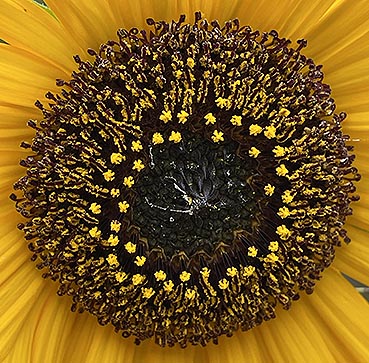The evolutionary history of sunflowers dates back to middle Eocene time, about 48 million years ago. That is when the former supercontinent Gondwanaland “broke apart,” forming South America, Australia, Africa, India, and Antarctica. The sunflower evolved in an ancient subtropical environment, most likely in northwest Patagonia, South America. The earliest fossils of sunflowers are extremely rare, especially considering that they are of two complete fossil flowers, with some associated pollen grains (Barreda, 2010).
Sunflowers were probably first domesticated in Mexico. Early Spanish explorers carried seeds from American plants to Europe (Wikipedia, 2025).
The classification of the sunflower is:
Kingdom Plantae
Order Asterales
Family Asteraceae (= the daisy family)
Genus Helianthus
Species H. annuus
The tallest record of a sunflower is 9.17 m (30 feet an one inch) (guinnessworldrecord.com). Interestingly, young sunflowers track the sun, thus they exhibit heliotropism) in odrer to maximize sunlight absorption for photosynthesis.
Sunflowers usually die each year, but they can reseed themselves and grow back. These flowers are referred to as “annuals.” Their species name indicates this fact. The sunflower illustrated below was, indeed, an annual that grew during a rather mild winter this past year in southern California. Other sunflower plants, however, are perennial and will return from their roots each year.
Sunflowers can be a color other than the usual bright yellow. They can be blue, purple, red, reddish, orange, or even very light-yellow. These cultivated variations are referred to as “cultivares” of the color (e.g., red, orange) (Wikipedia, 2025).
Each sunflower blossom is a composite flower. The outer part of the sunflower has large so-called petals, but more properly referred to as “ray flowers,” which are sterile. The black ring/disk (= the “flowerhead” or pseudanthium), at/near the center the plant consists, however, of numerous tiny “disk flowers,” also known as florets (Figures 3, 4, and 5, below). These are true, fertile tiny flowers that contain pollen (https://www.ndsu.edu/pubweb/chi).
Note: There can be considerable and "mind-blogging," genetic variation in the details of features of the black ring/disks and their flowers, even when they are part of the same sunflower plant (i.e., emanating from the same stem). The variation includes such features like the thickness of the ring/disk, the width of the band of florets, the shape of some florets, the color of the florets (some are yellow but some can be blue), etc. The details are far beyond the scope of a blog.
Sunflower seeds develop in association with the “disk flower,” after they have visited by flying insects. These seeds are a popular snack food, and they are harvested each year, after the sunflower plant has been pollinated by flying insects. There are two types of commercial sunflower seeds (small, all-black seeds, used for sunflower oil; and the larger non-oil seeds that are black and white “striped” and used in food (sunflowernsa.com.) (Figure 6). The non-oil seeds are the official state flower of the state of Kansas, in the United States.
References cited:
Barreda, V.D. 2010. Fossils of the daisy family. Science, v. 329, no. 5999. Online access to this journal requires a subscription.\
guinnessworldrecord.com
https://www. ndsu.edu/pubweb/chi)
sunflowernsa.com
Wikipedia. 2025.
FIGURES FOR THE TEXT GIVEN ABOVE
Fig. 1. A field of sunflowers (photo courtesy of Lindsey T. Groves, Collections Manager of Mollusks at the Los Angeles Natural History Museum).
Fig. 2. A home grown-sunflower plant (in my backyard) with the flower at the top not yet open. When this photo was taken, the plant was 5 feet tall. It eventually stopped growing at 6 feet tall. That was when the bulb at the top of the plant opened up and a yellow flower appeared.
Fig. 3. Same plant as shown previously. The bulb at the top is about ready to open up.
Fig. 4. An open bulb at the top of a sunflower immediately adjacent to the plant shown in the previous two photographs. The long, yellow petals surrounding the “black” central disk are called “ray flowers,” whereas the tiny yellow “dots” [in a ring that encircles the central-black] disk are the true, fertile individual flowers, commonly referred to as “disk flowers” or “florets.” The tiny yellow “dots” contain yellow pollen. The center of the central disk is black, without any florets or other recognizable structures.
Fig. 5. Close-up of another open-bulb at the top of another sunflower near the one shown in the previous figure. Diameter of the entire “black disk” 4.5 cm, with a ring of very tiny, five-rayed yellow “disk flowers (florets).” These florets have yellow pollen attached to them, and the pollen falls off, easily just by being touched with a finger (or by the encounter with a bee crawling around over the disk).
Fig. 6. Honey bees feeding on the pollen a sunflower (photo courtesy of Lindsey T. Groves, Collections Manager of Mollusks at the Los Angeles Natural History Museum).
Fig. 7. Non-oil sunflower seeds (the biggest ones are approximately 0.5 inches long). The seeds grow only within the centrally located, black-disk area.







No comments:
Post a Comment